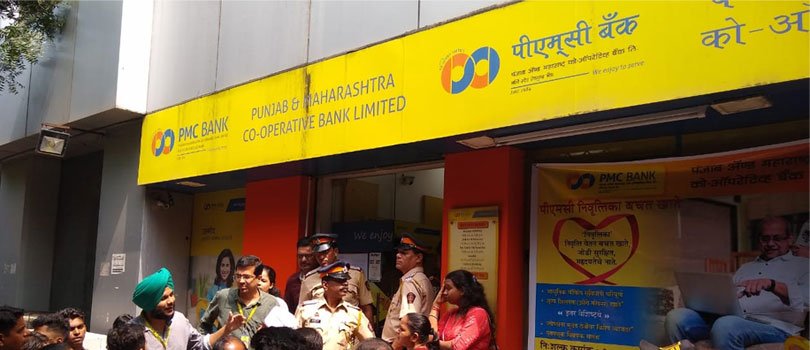Run on the Banks?
November 6, 2019 | Expert Insights

Background
The run on Punjab & Maharashtra Cooperative Bank (PMC) with all its attendant drama of human suffering, has gripped the attention of Indians who trust the Indian banking system with their life savings. The spectre of a lifetime of savings vanishing in a flash is a nightmare few Indians would like to contemplate.
PMC Banks fiscal collapse is not unique or an exception- the rot is much wider and deeper in the entire banking system. Since the last two years, the NPAs, came tumbling out of the cupboards, one major bank after the other. There were indications of complicity at the upper echelons of banking circles, especially where huge loans were doled out to cronies and poor monitoring by the regulatory authorities allowing such lapses to occur.
The tense fiscal atmosphere was further vitiated when shares in Yes Bank, collapsed by 40% as rumours swirled. Even the much-respected ICICI bank has been under clouds. Its chief, Chanda Kochar, once feted for breaking the glass ceiling of Indian banking hierarchy, was forced to go on leave pending investigations into disbursal of bad loans to her husband’s company. Similarly, Usha Ananthasubramanian, CEO Allahabad Bank was sacked when a 13000 crore fraud perpetrated during her watch in PNB came to light.
Analysis
In the past two years or so, Indian banks have seen their non-performing assets shoot up four times from 3% to over 13%. With their books increasingly in the red as loans had stopped being serviced, thus seriously diminishing their capital base. Without capital, and paranoid of making fresh mistakes, banks clamped down on loans. The resulting shock to the Indian economy and growth is there to be seen and needs no elaboration.
The origins go back to 2005. Conventional banks, which control about 4/5th of financial systems assets, lent generously to infra and industrial project, in many cases based upon political and business linkages. Later, the non-conventional banks, which are lightly monitored and control the balance 1/5th of the assets, also jumped in. When demonetisation took place, banks were flush with liquidity which further fuelled the loaning binge. At the root of the problem is the governance practices being followed in the higher echelons of the banking system. Loans, running into thousands of crores apiece, were being dished out not based upon hard-nosed business considerations.
Experts point towards the fundamental change made in 2002 in the loan making structure of banks. Before 2002, banks gave two types of loans- one to manufacturers, firms and farms (76% of banking portfolio) and second was retail loans to households for houses and cars etc (about 24%). Thereafter, banks got ambitious and as a growing India indulged in manufacturing and infra, banks started making aggressive term loans to companies for fixed capital investments like land, building and machinery. This type of loan is where bulk of the NPAs are locked and they account for almost 38% of bank portfolio.
The question that arises is how banks were not able to accurately assess the customer’s ability to service the loan. The answer lies in the fact that banks rely on credit rating agencies to asses creditworthiness which may not be accurate or not existing in case the company has not raised debt capital earlier from the market. Also, they cannot monitor whether the loan is being diverted for purposes other than which it was sought. In case they seek attachment of the asset being created from the loan, it mostly results in liquidation of the company itself and it is once again a loss-making preposition for them.
In case the collateral against which the loan is advanced has a value less than the loan, then the bank is in a bind as to how to recover its dues. Kingfisher NPA is a prime example of this.
Stress in the Banking Sector is fast becoming a global phenomenon. China is increasingly facing immanent closure of well-known banks. Eleanor Olcott, a China policy analyst at research firm TS Lombard, has observed that “ the biggest challenge facing China under the leadership of President Xi Jinping was neither the protests nor the trade war, but cutting risk in the banking system”. The bailout of Bank of Jinzhou and Baoshang Bank, a lender based in Inner Mongolia, are just the beginning of a wave of bank rescues China may be facing.
Assessment
- It is important that banks be periodically rated by an independent agency with respect to the yield curve of their loan portfolios. Those which have weak balance sheets will have to offer loans on higher interest rates. The corrective process should be from within the bank, and not externally imposed.
- The Government in general and RBI, in particular, cannot escape the blame for not maintaining a strict watch on the entire banking system. In the PMCB case, the auditors, the RBI and the government were not able to detect the massive fraud being done.
- Appointment of senior-level functionaries of PSBs must be a merit-based system with thorough background checks. In most case, the rot stemmed from the top including the role of middlemen in making senior appointments.
- In recent cases, the depositors have been the chief victims. The government should ensure that while liquidating the assets of a collapsed bank, the first priority should be the small retail customer rather than the big corporates houses. As on date, whatever may be the amount deposited by the retail customer, he is insured for a mere Rs 1 Lakh1
Image Courtesy: MoneyLife








Comments